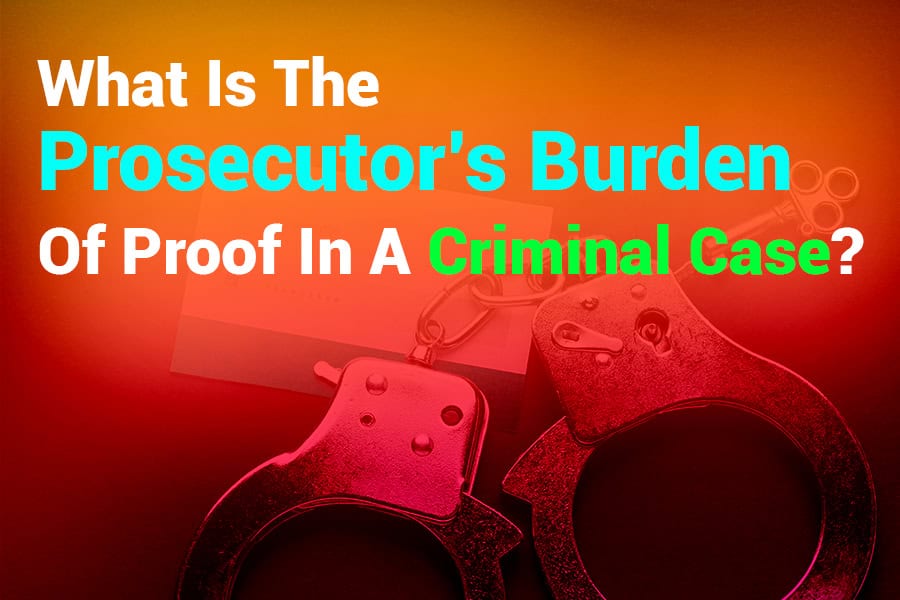The phrase “What is the prosecutor’s burden of proof in a criminal case?” is central to understanding criminal law and justice. This burden represents the prosecutor’s obligation to establish the defendant’s guilt beyond a reasonable doubt, a rigorous standard that guards against wrongful convictions. This article explores what this responsibility involves, why it’s essential, and the methods prosecutors use to meet it. For those interested in justice and legal principles, understanding the prosecutor’s burden provides insight into how fairness is maintained in the courtroom.
What is the Prosecutor’s Burden of Proof in a Criminal Case?
The prosecutor’s burden of proof in a criminal case requires establishing the defendant’s guilt beyond a reasonable doubt. This high standard protects the accused’s rights by ensuring they’re only convicted if evidence conclusively demonstrates their guilt.
What Is the Prosecutor’s Burden of Proof in a Criminal Case?
The concept of the “burden of proof” is central to criminal law, placing a critical responsibility on the prosecution to establish the defendant’s guilt. This requirement is more than a procedural rule; it’s a safeguard designed to ensure justice, preventing wrongful convictions based on insufficient or circumstantial evidence. In criminal cases, the burden of proof is exclusively on the prosecution, meaning they must prove the defendant’s guilt beyond a reasonable doubt. This high standard is a cornerstone of fairness in the justice system, reinforcing the presumption of innocence until guilt is definitively proven.
Purpose of the Burden of Proof in Criminal Law
The burden of proof’s placement on the prosecution serves a distinct purpose: it shields the defendant from having to prove their innocence, which could lead to unfair outcomes. If defendants were required to demonstrate their innocence, the justice system could risk wrongful convictions based on inadequate defenses. By requiring the state to present compelling evidence, the burden of proof ensures that only those cases with substantial evidence against the defendant proceed to conviction. This principle reflects the core value that a guilty individual should go free than an innocent person to be unjustly punished. By placing the responsibility to substantiate the case squarely on the state, the justice system strives to uphold this balance.
Beyond a Reasonable Doubt: A High Standard for Criminal Cases
The phrase “beyond a reasonable doubt” is critical to criminal law. In a criminal case, proving guilt beyond a reasonable doubt requires more than simply showing it is likely that the defendant committed the crime. It necessitates evidence that would convince any reasonable person of the defendant’s guilt with a high degree of certainty. This standard is essential to protect the accused, as criminal convictions often carry severe repercussions, such as loss of freedom, social stigma, and even life-threatening penalties. The demand for a high standard of proof serves as a safeguard against potential misuse of state power, reflecting the weight and gravity associated with criminal convictions.
Comparing Burdens of Proof in Criminal and Civil Cases
A key difference between criminal and civil cases lies in the burden of proof. In civil cases, which typically involve personal or financial disputes, the burden of proof is set at “preponderance of the evidence.” This standard is significantly lower than “beyond a reasonable doubt” and requires only that the evidence shows something is more likely true than not. In criminal cases, however, where outcomes can drastically alter an individual’s life, the burden of proof is heightened to protect against wrongful convictions. This distinction ensures that criminal cases are handled with an added layer of security for the accused, demanding a nearly irrefutable case from the prosecution.
The Burden of Proof: A Cornerstone of Fairness and Integrity
Ultimately, the burden of proof in criminal law is foundational to a fair justice system. By holding the prosecution accountable to a high standard, the justice system underscores its commitment to safeguarding individual rights and ensuring that only those proven guilty beyond reasonable doubt are convicted. This burden influences the presentation and evaluation of evidence, maintaining the integrity of the judicial process by guarding against unjust convictions. Given the profound consequences of criminal convictions, the burden of proof is a vital protection, reinforcing the principle that every individual deserves a fair and unbiased opportunity to defend themselves in court.
How Does the Prosecutor Meet the Burden of Proof?
To convince the court and jury of the defendant’s guilt, prosecutors must present a well-rounded, compelling case that incorporates solid, reliable evidence. They achieve this by using various types of evidence and testimonies to form a comprehensive picture of the alleged crime, showing not only what happened but also how the defendant was involved. Key approaches include presenting concrete evidence, using witness testimonies to build credibility, leveraging expert witnesses for specialized insights, and employing demonstrative evidence to simplify complex facts for the court.
Presenting Evidence
Concrete evidence serves as the backbone of the prosecution’s case, providing tangible proof that supports their claims. Evidence can take many forms, each playing a unique role in establishing the facts. Physical evidence, such as fingerprints, DNA samples, or weapons, is often powerful, as it can directly connect the defendant to the crime scene or victim. Documentary evidence, like emails, texts, or contracts, is another crucial type, especially in cases where the intent or motive needs to be established. Circumstantial evidence, although indirect, can also be impactful by creating a chain of events or circumstances that suggest the defendant’s involvement. By carefully gathering and presenting these various types of evidence, prosecutors aim to create a cohesive narrative that satisfies the high burden of proof.
Witness Testimonies
Witness testimonies are another critical component in establishing guilt beyond a reasonable doubt. Witnesses provide firsthand accounts of events, interactions, and behaviors that can corroborate or refute claims made by the prosecution. The credibility of witnesses is crucial; therefore, prosecutors meticulously select individuals whose accounts strengthen their case. Direct examination, where the prosecution questions witnesses to bring out essential facts, is an opportunity to build a compelling narrative that aligns with the evidence. Credible witnesses, such as bystanders who saw the crime unfold or individuals who interacted with the defendant around the time of the incident, help establish a factual framework. Witness testimonies can provide powerful support for other evidence, reinforcing the prosecution’s version of events and enhancing the overall credibility of their case.
Expert Witnesses
In complex cases involving technical or specialized information, expert witnesses play a vital role. These individuals have expertise in fields such as forensics, medicine, or technology, and can provide interpretations or insights that laypersons might not fully understand. For example, a forensic analyst might explain the significance of DNA findings, while a medical expert could discuss autopsy results or injury patterns. Expert witnesses help the jury make sense of complicated evidence, translating technical findings into terms that support the prosecution’s argument. By adding this layer of specialized knowledge, expert witnesses contribute to the overall strength and clarity of the prosecution’s case.
Demonstrative Evidence
Demonstrative evidence includes visual aids, re-enactments, diagrams, or models that help illustrate key facts. This type of evidence is especially useful in cases with intricate details that may be challenging for jurors to grasp through verbal descriptions alone. Prosecutors might use re-enactments to recreate how the crime occurred or diagrams to map out the crime scene. These visual aids make complex information more accessible and allow the jury to better understand the case’s nuances. Demonstrative evidence is an effective tool for reinforcing other forms of evidence, as it enables jurors to see and interpret the facts in a clearer, more tangible way.
By employing these methods, prosecutors work to construct a compelling case that meets the high standard of proving guilt beyond a reasonable doubt. Through concrete evidence, credible witnesses, expert insights, and visual clarifications, they create a narrative designed to leave no room for reasonable doubt in the minds of the jurors. Each piece of evidence and every testimony contribute to a cohesive case that aligns with the legal standards required for a conviction in a criminal trial.
Components in Meeting the Burden of Proof
To meet the rigorous burden of proof required for a criminal conviction, prosecutors must establish several core elements: actus reus (the guilty act), mens rea (the guilty mind), causation, and concurrence. Each of these components is crucial for building a persuasive case that supports the defendant’s guilt beyond a reasonable doubt. Together, they create a comprehensive narrative, showing that a crime not only occurred but that the defendant intentionally committed it and caused the resulting outcome. Here’s a closer look at each element:
- Actus Reus (The Guilty Act): The first essential element, actus reus, refers to the actual criminal act or conduct constituting the offense. It establishes that a specific, illegal action took place. For instance, in a theft case, actus reus might involve the physical act of taking someone else’s property without permission. Prosecutors need solid evidence, like surveillance footage, eyewitness accounts, or physical items, to prove the defendant committed the alleged act. Without this element, the case has no foundation, as the legal system does not punish thoughts or intentions alone.
- Mens Rea (The Guilty Mind): Men’s rea, or the “guilty mind,” addresses the defendant’s mental state and intentions at the time of the crime. Criminal liability requires the prosecution to prove that the defendant acted intentionally, knowingly, recklessly, or with criminal negligence. For example, first-degree murder charges require evidence of premeditation and intent to kill, while involuntary manslaughter may require proof of reckless disregard for risk. Distinguishing between accidental and intentional actions is vital for ensuring that only those with criminal intent are held accountable.
- Causation: Once actus reus and mens rea are established, prosecutors must prove causation—showing that the defendant’s actions directly caused the harm that defines the crime. For example, in an assault case, the prosecution must demonstrate that the defendant’s actions were the primary cause of the victim’s injuries. This often involves proving both factual causation (“but for” the defendant’s actions, the harm wouldn’t have occurred) and legal causation (the action was sufficiently connected to the harm). This element ties the defendant’s conduct directly to the crime’s outcome.
- Concurrence: Concurrence requires that the act (actus reus) and intent (mens rea) occur simultaneously. Prosecutors must show that the defendant had the necessary criminal mindset while committing the act. For instance, if someone accidentally harms another without intending to, they lack the concurrence of act and intent, and criminal liability may not apply. This element ensures fairness by requiring that only those whose illegal actions align with criminal intent face punishment.
Why the Burden of Proof is so High in Criminal Cases
Unlike in civil cases, where the burden of proof is based on a “preponderance of the evidence,” criminal law demands proof “beyond a reasonable doubt.” This high standard serves crucial moral, ethical, and legal functions that reflect society’s commitment to justice. Rooted in historical context, it protects individuals from wrongful convictions, emphasizing the principle that a guilty person should go free rather than for an innocent person to be unjustly punished.
One key reason for this strict standard lies in the severe consequences that accompany criminal convictions, including loss of liberty, damage to reputation, and, in some cases, life-altering penalties. Because these consequences are so profound, the law enforces a high burden of proof to ensure that only those whose guilt is convincingly established face punishment. This standard reflects a moral and ethical stance: the legal system recognizes that the risk of incarcerating an innocent person is far more damaging to society than occasionally allowing a guilty person to go free.
The principle of the “presumption of innocence” is central to this high burden. Under this principle, every individual is assumed innocent until proven guilty, placing the onus entirely on the prosecution to prove otherwise. This presumption aligns with the fundamental rights of defendants, granting them a fair opportunity to defend themselves without the pressure of proving their own innocence. It also aligns with historical values in democratic societies that prioritize individual rights and protection from the state’s power.
By enforcing the “beyond a reasonable doubt” standard, the justice system safeguards against the risks of wrongful convictions, maintaining a high level of integrity in legal proceedings. This standard is not just a procedural requirement; it is a cornerstone of criminal justice that upholds the fairness, humanity, and rigor of the legal process, ensuring that defendants are treated equitably and that justice is served responsibly.
What Happens if the Prosecutor Fails to Meet the Burden of Proof?
When the prosecution fails to meet the burden of proof, the case typically ends in acquittal, upholding the defendant’s presumption of innocence. This outcome occurs because criminal law requires the prosecution to prove the defendant’s guilt “beyond a reasonable doubt”; if doubt remains, the jury or judge must side with the defendant, resulting in a not-guilty verdict. This high standard serves as a safeguard, ensuring that no one is wrongfully convicted without compelling evidence.
The defense plays a crucial role in creating this doubt. Defense attorneys strategically scrutinize the prosecution’s evidence, cross-examine witnesses, and identify inconsistencies to question the credibility of the case. By challenging the strength and reliability of the evidence, the defense can make it difficult for the prosecution to convince the jury beyond reasonable doubt. This approach often involves presenting alternative explanations or highlighting gaps in the prosecutor’s arguments.
If the jury or judge finds that the prosecution has not fulfilled its burden, the defendant is acquitted, meaning they are legally cleared of the charges. This can have significant post-trial impacts. For the defendant, an acquittal brings relief and the ability to resume their life without a criminal conviction. For the prosecution, it may highlight areas where evidence collection or case strategy could improve. For victims, however, an acquittal can bring disappointment, as it may feel like justice has not been served. Ultimately, this outcome reinforces the justice system’s commitment to fairness by ensuring that only those proven guilty face penalties.
Conclusion
what is the prosecutor’s burden of proof in a criminal case? In criminal law, the prosecutor’s burden of proof is not just a procedural requirement but a cornerstone of the justice system, aimed at protecting fairness and preventing wrongful convictions. This burden—proving guilt “beyond a reasonable doubt”—is crucial for upholding the integrity of the legal process. It serves as a protective measure, ensuring that no one is convicted based on insufficient or dubious evidence. By placing this burden squarely on the prosecution, the law enforces a rigorous standard that emphasizes the value of individual rights and the presumption of innocence.
FAQ’s
Q. What is the prosecutor’s burden of proof in a criminal case?
A. The prosecutor’s burden is to prove guilt beyond a reasonable doubt, ensuring convictions only when evidence is conclusive.
Q. How does the burden of proof protect defendants?
A. This standard prevents convictions based on weak or insufficient evidence, protecting innocent individuals.
Q. What if the burden of proof isn’t met?
A. The defendant is acquitted, reinforcing the presumption of innocence.
Q. Why is the burden of proof higher in criminal cases than in civil cases?
A. Criminal cases carry the potential for loss of liberty, requiring a higher standard to avoid unjust punishment.
Q. How can a defense lawyer challenge the burden of proof?
A. By identifying inconsistencies, presenting counter-evidence, and creating reasonable doubt to weaken the prosecution’s case.




